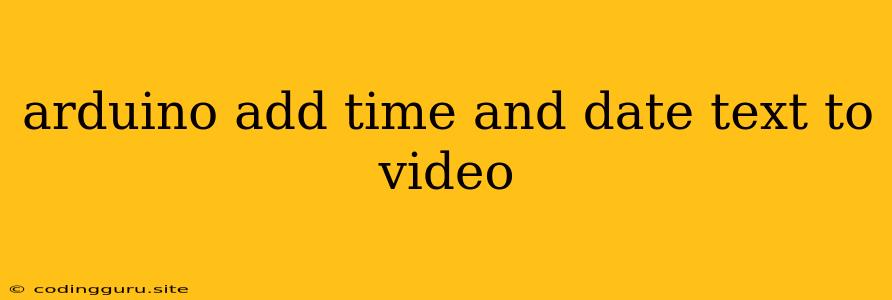Adding Time and Date Text to Video with Arduino
Adding a timestamp to your videos can be incredibly useful for documentation, organization, and even artistic expression. While you can achieve this directly with video editing software, utilizing an Arduino can open up a world of possibilities, especially if you're working with real-time applications or need a custom timestamp format.
Why Use Arduino?
Arduino's affordability and ease of use make it an ideal platform for projects like this. By combining Arduino with a simple video capture setup, you can:
- Generate dynamic timestamps: Instead of manually adding a static timestamp, Arduino allows you to display the time and date in real-time as the video is being recorded.
- Customize the timestamp format: Tailor the timestamp to your needs – display only the time, add a specific date format, or even include other data like the current temperature or other sensor readings.
- Trigger video recording based on events: Integrate Arduino with sensors to start and stop video recording based on specific events, like motion detection or a button press, and automatically add the corresponding timestamp.
How Does it Work?
The core principle involves using Arduino to read the current time and date, format it as desired, and then send this information to your video capture setup. This setup can involve:
- A camera connected directly to Arduino: You'll need a camera module with an SPI or I2C interface that Arduino can control.
- A computer with a webcam: Arduino can send timestamp data via a serial connection to a computer running video recording software.
Key Components
- Arduino board: Any Arduino board will work, but a board with more memory and processing power might be beneficial for more complex projects.
- Real-Time Clock (RTC) module: An RTC module like the DS3231 provides accurate timekeeping even when the Arduino is powered off, ensuring consistent timestamps.
- Camera module: Choose a camera with a suitable interface that can be easily integrated with Arduino.
- Video recording software: For computer-based setups, you'll need software like OBS Studio or VLC to capture the video and display the timestamp.
Getting Started: Basic Setup
- Connect Arduino to the RTC module: Connect the RTC module to Arduino according to its datasheet.
- Install the necessary libraries: You'll need the RTC library to interact with the RTC module.
- Get the current time and date: Use the RTC library's functions to read the time and date from the RTC module.
- Format the timestamp: Convert the time and date data into your desired format using Arduino's built-in formatting functions.
- Send the timestamp data to your video setup: Depending on your setup, you can send this data via the serial port to a computer or directly to the camera module.
Sample Code:
#include
#include "RTClib.h"
RTC_DS3231 rtc;
void setup() {
Serial.begin(9600);
Wire.begin();
rtc.begin();
}
void loop() {
DateTime now = rtc.now();
// Format the timestamp as "YYYY-MM-DD HH:MM:SS"
String formattedTime = String(now.year()) + "-" + String(now.month(), DEC) + "-" + String(now.day(), DEC)
+ " " + String(now.hour(), DEC) + ":" + String(now.minute(), DEC) + ":" + String(now.second(), DEC);
Serial.println(formattedTime);
delay(1000);
}
Advanced Techniques:
- Adding custom text: You can combine the timestamp with other text or data like sensor readings.
- Dynamic text overlays: Use Arduino to control the appearance of the timestamp, changing its size, color, or position based on different events.
- Triggering video recording: Utilize Arduino's input pins to trigger the start and stop of video recording based on events.
- Creating time-lapse videos: Combine Arduino with a camera module to capture images at regular intervals and then use video editing software to create a time-lapse video.
Conclusion
Adding timestamps to videos with Arduino can open up a range of possibilities, from simple date and time displays to complex event-triggered video capture. With a little experimentation and coding, you can easily transform your Arduino into a versatile tool for adding dynamic and informative timestamps to your video projects.
